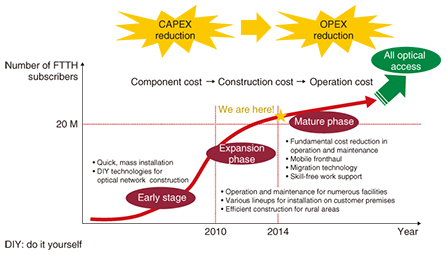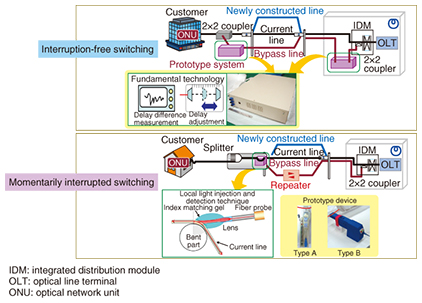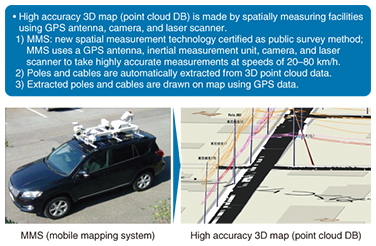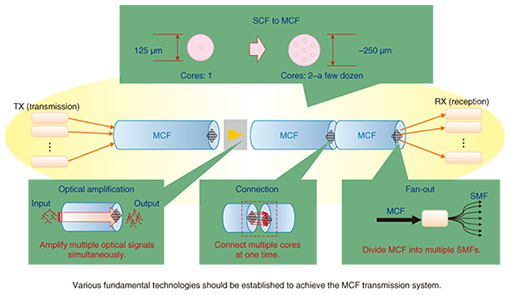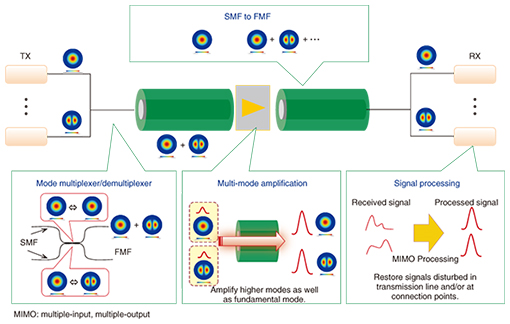 |
|
|
|
|
|
Feature Articles: NTT Tsukuba Forum 2014 Workshop Lectures Vol. 13, No. 3, pp. 58–64, Mar. 2015. https://doi.org/10.53829/ntr201503fa10  R&D Trends in Optical Fiber and Cable TechnologyกกAbstractAt NTT Access Network Service Systems Laboratories, we are engaged in research and development (R&D) of optical fiber and cable technologies that contribute to drastically reducing network costs. This article introduces the latest R&D in maintenance and operation technologies for effective maintenance and management of a massive number of optical facilities. It also reviews next-generation optical fiber technologies to handle the explosive future growth of data traffic. Keywords: optical fiber and cable, maintenance and operation technology, next-generation optical fiber technology 1. IntroductionNTT has been involved in the development of optical fiber technology for over 40 years. A commercial optical fiber service was started in Japan in a trunk-line network in 1982, and the Japan longitudinal optical fiber network was completed in 1985. Since then, the transmission capacity has expanded year by year to meet the growing demand and to implement technical advances. In access networks, the full-scale fiber-to-the-home (FTTH) service called B FLET’S began in 2001. NTT laboratories have developed various optical components and systems to implement these commercial optical fiber services. In the recent decade, in particular, we have focused on improving fiber and cable technologies for optical access networks to further promote the FTTH service. A recent typical research and development (R&D) achievement is a bending-loss insensitive fiber we developed using holey fiber technology. A hole-assisted fiber, which is one type of holey fiber, has much higher resistance to optical bending loss compared to the conventional optical fiber and has been applied commercially as bending-free optical fiber cord, gap wiring indoor cable, and jumper cable for office buildings. These optical cords and cables may prevent an increase in accidental bending loss in customer homes and office buildings, where there are many opportunities to handle such cords and cables directly. In addition, these optical cords and cables make it possible to deliver optical cable into customer homes, where it was once difficult to wire conventional cable. 2. Future direction of R&D of optical fiber and cable technology2.1 Target of optical fiber and cable technologyThe transition in the number of FTTH subscribers can be divided into three phases (Fig. 1): an early stage, expansion phase, and mature phase. In the early stage, quick, mass installation was very important. In the expansion phase, it became important to construct optical facilities economically in order to expand service areas, especially where it was difficult to deliver service such as in rural areas. In the mature phase, however, it is becoming increasingly important to efficiently maintain and manage the huge number of existing optical facilities. In fact, our R&D focus has been shifting from how to reduce the construction cost, i.e., CAPEX (capital expenditure), to how to maintain and operate optical facilities effectively, i.e., OPEX (operating expenditure), as shown in the figure.
2.2 Two main objectives of R&D of optical fiber and cable technologyIn view of the transition in the R&D target, we are conducting our R&D activities by focusing on two main objectives. First is the creation of new technologies for the operation and maintenance of optical network facilities as a short- to medium-term objective. To reduce the maintenance and operation cost of optical access networks, it is important to create new technologies by converging optical fiber technology and the latest information technology. Second is the innovation of next-generation optical fiber as a medium- and long-term objective. It is expected that the conventional fiber will not be able to handle the explosive growth in traffic in the future. The limited transmission capacity of optical fiber is a continuous challenge that we also intend to tackle. 2.3 Direction of R&D of optical fiber and cable technologyThe direction of R&D of optical fiber and cable is considered to have three axes: workability, operability/maintainability, and capacity/functionality. We are proceeding with our R&D activities having set the following four technology goals on these three axes. (1) Easy and effective construction - Cable design technology - Optical connection technology (2) Effective maintenance and operation - Optical local injection/detection - Fiber switching technology (3) Precise and quick remote fault location - High resolution and long distance measurement - Measurement technique for PON (passive optical network) architecture (4) Ultrahigh capacity fiber - New structure fiber (holey fiber) - Multi-core and few-mode fiber 3. Recent R&D topics involving optical fiber and cableWe introduce here some of the R&D themes we have focused on recently. 3.1 Optical line switching technologyFirst, we introduce optical access line switching technology, which can minimize service interruption caused by fiber route changes. We have been studying this technology by focusing on two approaches. One is interruption-free switching, and the other is momentarily interrupted switching (Fig. 2).
In interruption-free switching, route switching is achieved without an interruption in service by preparing a bypass line, which is used temporarily to duplicate in-service lines. Finally, service is switched to a newly constructed line. The key technologies for this are delay difference measurement to precisely measure the signal delay between two different lines (between the current line and the bypass line, and between the bypass line and the newly constructed line) and delay adjustment to control and adjust the signal delay. By improving this technology, we have been able to reduce the volume of equipment by 40 times (14 L) and to reduce the adjustment time by 1000 times (less than 3 seconds for a 1-km adjustment) compared to the original time. This improvement has enabled us to advance this switching technology to the practical use level. Route switching in momentarily interrupted optical line switching technology is carried out by using a local light injection and detection technique in order to formulate a bypass line. In this scheme, bending is temporarily applied to the currently used line to switch an optical signal from the current line to a bypass line or from a bypass line to the newly constructed line. A very short service interruption occurs during switching, but this scheme is advantageous in that it can achieve switching with a very simple system configuration compared to interruption-free switching. The local injection and detection technique is the key technology to realize this system. It enables input-output of signal light through the fiber coating without cutting the fiber. To detect very weak light signals leaking from the fiber and to input light signals into the fiber efficiently, it is necessary to adjust a fiber probe with a high degree of accuracy. We have developed a highly efficient local injection/detection system by designing an appropriate probe position to maximize the coupling efficiency and by devising an optical coupling scheme. These two line-switching systems can be selected according to the work situation in the field. We believe that this new technology will make it possible to complete line-switching tasks more effectively and without service interruptions. We are now conducting a field trial by using prototype systems to identify practical problems, including those involving operation and procedures for line-switching work. We plan to further improve this technology taking the results of the field trial into account in order to establish it as a total solution for line-switching work. 3.2 Coated fiber connection techniqueNext, we introduce our coated fiber connection technique, which makes it possible to cut and connect optical fiber without removing the fiber coating. The use of this technique eliminates the need to remove the fiber coating and to clean the fiber, and thus, the tools for this work (stripper, alcohol, paper, etc.) become unnecessary. Moreover, this connection technique reduces the risk of fiber breakage because it does not require field workers to handle bare fiber directly. This novel new connection approach incorporates two important key technologies. The first involves cleaving a coated optical fiber, and the second consists of removing the fiber coating in a connecting component. For the cleaving method, we found that a stretching method was suitable for cleaving the coated fiber over a wide temperature range. We also clarified that for the removal technique, improving the shape of the part of the connecting component the coating was removed from made it possible to remove the fiber coating more effectively over a wide temperature range. We will continue to improve this technique in order to reduce the cost of the cleaver device and increase the percentage of successful outcomes in almost every work environment. 3.3 3D facility management technologyWe are working to reduce the total cost of outside facility management and make outside work more efficient by establishing outside facility databases (DBs) and business applications based on three-dimensional (3D) computer-aided design (CAD) technology. This technology is aimed at making design and maintenance work for outside facilities simpler and more effective by constructing a 3D CAD-based outside facility DB and business applications, instead of using the conventional 2D plant records (Fig. 3). This new technology is characterized by the use of a mobile mapping system (MMS) to build a highly accurate 3D map. MMS is a new spatial measurement technology certified as a public survey method; it is equipped with a GPS (Global Positioning System) antenna, an inertial measurement unit, a camera, and a laser scanner. It performs highly accurate measurements at speeds from 20 to 80 km/h. We are developing a 3D point cloud DB with MMS that can automatically extract outside facilities such as poles and cables from 3D point cloud data and identify extracted facilities by accessing an existing facility DB system.
One application example is automatic detection of pole deflection and the height of cables from the 3D point cloud DB. This enables us to select particular facilities that preferentially need to be inspected from a massive number of network facilities. Moreover, by analyzing changes in the 3D point cloud DB over the years, the system can be used to automatically indicate unsafe facilities on a map. This novel facility management system is expected to contribute to making inspection work of various facilities more efficient because it eliminates the need to dispatch workers to the field to inspect each piece of facility equipment. 3.4 Remote fault location measurement for PON architecturePON technology has been widely adopted to deliver FTTH services to save the cost of cables and optical transceivers. One of the critical issues with PON configuration is how to monitor the faults in tributaries of the optical splitter, because conventional optical time-domain reflectometry cannot obtain accurate loss distributions beyond the optical splitter. We have devised a novel remote measurement technique that enables us to obtain the loss distribution of each branched fiber below the optical splitter using a physical phenomenon called Brillouin scattering. In this new measurement method, two optical pulses—a pump pulse and a probe pulse—are launched into an optical fiber with a time delay from an apparatus in the central office. The two launched pulses go into branched fibers through an optical splitter and are reflected at an optical termination filter installed in front of an optical network unit (ONU). Because the two pulses are injected with a time delay, the probe pulse, which is launched prior to the pump pulse, reaches the reflection point at the end of the branched fiber first, and it collides with the pump pulse, which is launched with a time delay, in the tributary fiber. The optical frequencies of the two pulses are set to have a difference between them that corresponds to a Brillouin frequency shift. When the two pulses collide, Brillouin scattering occurs in the fiber, which is when part of the energy is transferred from the pump pulse to the probe pulse. We can obtain the loss distribution of each tributary in order to analyze the returned probe pulses at the apparatus, while controlling the timing of the pulse launches. We confirmed that we were able to identify the faulty fiber and the accurate fault location in a PON configuration with an 8-branched splitter by using this method. This new method is therefore effective for identifying fault locations in fiber branches where failures tend to occur without having to dispatch workers to the field. If this approach can be implemented practically, it will help to overcome one of the major difficulties with PONs and will also reduce maintenance costs. 3.5 Next-generation ultrahigh speed and capacity fiber technologyThe bandwidth of optical fiber communication systems that form the backbone for this communication is being increased yearly. So far, transmission capacity per optical fiber has increased by using time division multiplexing (TDM) and wavelength division multiplexing (WDM) and by increasing the multiplexing density and signal density based on various breakthroughs. However, as the density of signal multiplexing increases, the power density per cross section of fiber inevitably increases. High power density in optical fiber is known to cause nonlinear optical effects, which degrade signal characteristics, and fiber fuse, which destroys optical fiber thermally. When the power density threshold and the bandwidth of the optical amplifier are taken into consideration, it is said that the maximum transmission capacity of conventional single-mode fiber (SMF) is limited to around 100 Tbit/s. Space division multiplexing (SDM) is thought to be a potential candidate as the next multiplexing axis to break through the capacity limitation. Thus, new optical transmission technology is expected to meet the growing demand for transmission capacity. In terms of the transmission medium, two design concepts have been proposed for realizing SDM. One is multi-core fiber (MCF), which has multiple individual cores in a fiber, and the other is few-mode fiber (FMF), in which multiple different transmission modes can be transmitted within a single core. We are conducting research on the transmission medium for SDM technology in order to extend the transmission capacity to meet the future explosive increase in data traffic. The MCF transmission system is illustrated in Fig. 4. The transmission system with MCF consists of some fundamental technologies as well as those for fiber design and manufacturing. These include optical amplification technology, which amplifies multiple optical signals simultaneously; connection technology, which connects multiple cores at one time; and fan-out technology, which divides MCF into multiple SMFs. We are now conducting research on MCF in a national project launched by Japan’s National Institute of Information and Communications Technology (NICT), which has established an industry-academia research group. One of the achievements in this project is that we conducted the first trial of a multi-vendor interoperability experiment with MCF technology in 2013. We constructed a 100-km-long transmission line consisting of MCF with seven cores provided from five different fiber vendors, and other optical components such as amplifiers, connectors, and fan-out cords. We confirmed in the transmission experiment that transmission signals in the seven individual cores were successfully transmitted simultaneously without noticeable interference. We believe that this interoperability experiment is highly significant from a practical application perspective.
Fundamental technologies for mode division multiplexing transmission are shown in Fig. 5. Mode division multiplexing is a transmission scheme in which multiple optical modes individually modulated with signals are transmitted in a single-core optical fiber. The key technology with the multi-mode fiber used for SDM is the effective control of individual optical modes, in contrast to conventional multi-mode fiber. Mode division multiplexing systems are also based on various fundamental technologies as well as fiber design and manufacturing technology, for example, mode multiplexer/demultiplexer technology, in which individual modes are multiplexed and demultiplexed; multi-mode amplification technology, in which higher modes as well as fundamental modes are amplified; and signal processing technology, which restores signals disturbed in the transmission line and/or at connection points. We successfully carried out the first ever mode division multiplexing transmission experiment, in which two modes that were modulated individually were transmitted in one fiber; this achievement was reported at the Optical Fiber Communication (OFC) Conference in 2011.
We have also reported world-leading data in the field of mode division multiplexing transmission technology such as multi-mode fiber with a trench-assisted graded index core in which six LP (linearly polarized) modes (ten modes if degenerate modes are included) can be transmitted with low differential mode dispersion and in a wide wavelength region, and a planar lightwave circuit (PLC) type mode multiplexer/demultiplexer, which can multiplex and demultiplex four individual modes in one PLC chip. In terms of SDM technology, we will continuously strive to tackle the limitation in the transmission capacity of optical fiber and also to make progress in the practical use of SDM technology. Author profileCareer highlightsExecutive Research Engineer, Executive Manager, Supervisor, Access Media Project, NTT Access Network Service Systems Laboratories. He received the B.E. and M.E. in physics and the Ph.D. in electrical engineering from Kyushu University in 1988, 1990, and 2000, respectively. He joined NTT Transmission Systems Laboratories in 1990 and studied low-loss optical fiber and nonlinear optical effects in optical fiber. He has over 20 years of experience in optical fiber and cable research, development, and standardization. He has served as a rapporteur of ITU-T SG15 Question 8. He is a member of IEICE (Institute of Electronics, Information and Communication Engineers) of Japan. |
|









